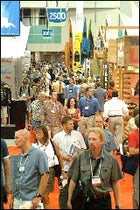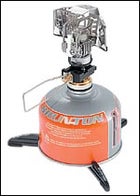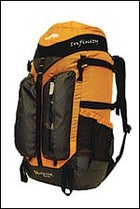My epiphany about the future of gear came not from the floor of the Outdoor Retailer Summer Market, mid-August’s annual gear orgy in Salt Lake City, but from Louis, a New Yorker who was at the show as a dealer representative. We met late Friday night in the Wyndham Hotel bar while watching the Seattle Mariners on TV, him swilling bad Scotch, me a bad gin and tonic.
 Where’s Doug?: The OR floor show
Where’s Doug?: The OR floor show Taking it outside
Taking it outside
“The thing about this business,” Louis said, exhaling a long plume of cigarette smoke just as Ichiro fouled off his fourth pitch in a row, “is that it’s not like the shoe business. There you’ve got Nike and Reebok and that’s about it. But here, anybody with a decent product can come in and create a business. It’s MUCH more democratic.”
I was busy watching Ichiro valiantly trying to park one in the stands. But I was also listening, and had to agree. The outdoor industry IS like that. It’s true that the mom-and-pop retail shops are getting fewer and farther between, and the big players perhaps have too much influence. But it’s astonishing to come to the show, year after year, and always find somebody new pitching a new product. They’re not always trying to get rich, either. They had an idea for a product, and think other people will share their passion. And often as not, they find a market. Because good stuff sells.
Case in point: , a company making sleeping bags, tents, and pads that I first came across at the show maybe three years ago. The founder, a friendly guy named Bill Gamber, was hawking a bag that had no insulation on the bottom; instead you used a sleeping pad, saving both weight and money. I think he had a tent, too. The bag idea wasn’t new, and tents, well, they were everywhere. I looked at his gear, wished him well, and figured I’d never see him again. But Bill and Big Agnes are still around, and they’re doing great. This year he added five new sleeping bags, including the zero-degree Storm King (three pounds, two ounces; $199) and four new tents, such as the three-person Seedhouse 3 (four pounds, eight ounces; $239). The stuff isn’t the lightest, or the warmest, or the sturdiest. But it looks good, it works, and it’s priced well. And, yes, people have responded—Big Agnes’ business is holding up and even growing despite the gloomy economy.
: The Gear Guy’s Roundup
Stars in their ideas
 Shocking filler?: �ղ������Ի��é's Shocking Blue
Shocking filler?: �ղ������Ի��é's Shocking BlueSo whose new little booth at this year’s show will be bigger and better stocked in two or three years? Well, if I could predict the future I would have dumped that Quokka.com stock (anybody remember that turkey?), but I’ll take the plunge and put my money on a little French company called . Run by a charming fellow named Niels-Henrik Friisbøl, �ղ������Ի��é makes down sleeping bags and clothing. “So what?” you say. So, these are really, really, really GOOD products. As in, the nicest I’ve ever seen, and with Marmot, Western Mountaineering, and Feathered Friends in the same race, that’s a pretty high bar.
A case in point is their Shocking Blue, a minus-13-rated bag that comes in—yup, you guessed it—blue. Stuffed with 850-plus-fill down that Niels-Henrik buys personally from goose farmers in the Pyrenean foothills, the bag consists of some 105 individually cut and sewn Pertex nylon panels. The hood, for instance, doesn’t end with a taper caused by the stitching. It ends with a full nylon baffle, so that even when it’s drawn tight, you still have two inches of lofted insulation over your forehead. And the interior panels are cut in such a way that when you lie inside, the entire bag very gently curves upward so that its top just skims your body. It feels weightless.
Alaskan guides have tested this bag and love it. But will the U.S. market buy into it? At $600 a pop, it’ll be a hard sell. But my bet is that �ղ������Ի��é will find a place here.
: The Gear Guy’s Roundup
More from the floor: Part I
 Leading light: Brunton’s Liberty lantern
Leading light: Brunton’s Liberty lantern Micro-home on the range: the Infinity from GoLite
Micro-home on the range: the Infinity from GoLiteOf course, there were thousands of other things on display at the show, which spills out of the cavernous Salt Palace Convention Center into outdoor pavilions (a fancy word for “big tents”) and display areas. I walked constantly for two full days and didn’t see it all. But here are some things that caught my eye:
LET THERE BE LIGHT
Sometimes I like to camp with a gas lantern, particularly when bike touring. Especially in winter, a lantern will cheer up an otherwise dark and gloomy evening. But candle lanterns don’t throw out much light for their weight, and gas lanterns require fabric mantles that invariably break when the lantern is moved. is addressing that problem with its new Liberty, using a platinum mantle that is essentially unbreakable with normal use. And it’s light—only eight ounces, not including a butane/propane canister to fire it. And even that doesn’t add much; a single canister can keep the Liberty burning for six hours at full throttle, generating about as much light as an 80-watt bulb. Price is $110.
LET THERE BE…MORE LIGHT
It seems as if the entire outdoor-gear industry has gone on a diet, with this year’s loot even slimmer. Examples: Torrent Flier Jacket, a full Gore-XCR technical jacket that weighs an absurd 12 ounces. It’ll be $229. is adding to its single-wall tent lineup with the new Airjet 2, which sleeps two and weighs just under four pounds. That’ll be $285. And , which has really tried to define the ultralight category in recent years, was showing a new pack called the Infinity. It has more than 3,000 cubic inches of capacity, comes with an internal frame sheet, yet weighs just two pounds, five ounces. It’ll set you back $199.
FEET TO THE FLOOR
With ranks of shoes as far as the eye can see, a couple of pairs did manage to grab my attention at the show. , a traditional Italian boot maker that’s long been turning out beautiful if somewhat porky leather boots, is building footwear more suited to the lighter loads made possible by today’s lighter gear. One I hope to try soon: the new ZG-40, a good-looking leather hiker for $149. Trail runners may want to look for XA Pro 2 ($90), an upgrade of the popular XA. It has a gusseted tongue to keep out crud, and tough mesh uppers. Climbing-shoe maker , meanwhile, was showing a new line of budget-priced rock shoes called CaVa. They’ll sell for $69 to $79. Good, sticky soles, but with lesser leather and a lower-quality fit compared with their higher-end products. High-end rock shoes on display included spiffy Venom, a high-performance slipper that will sell for $130.
Think Globally
Yes, it is possible to earn college credit by researching rhinos in Botswana and studying Spanish in Ecuador. Get out your passport and sign on with one of the nation’s leading study-abroad programs.



University Studies Abroad Consortium (775-784-6569, ) Choose from among 19 countries in Africa, Europe, Asia, and Oceania. The International Partnership for Service Learning (212-986-0989, ) With contacts in India, Ecuador, Russia, and ten other countries, IPSL enriches cultural experiences by having students live with a local family and volunteer in the community. School for International Training (800-257-7751, ) SIT advocates an interdisciplinary, experiential, field-based approach through dozens of programs worldwide—from wildlife ecology in Tanzania to cultural studies in Cuba. International Studies Abroad (800-580-8826, ) ISA pairs students with host universities in 15 cities in Central and South America and Europe, and offers a multicountry semester that takes students from Guanajuato, Mexico, to Buenos Aires and on to Seville, Spain. Council on International Educational Exchange (800-407-8839, ) CIEE has 60 programs in 29 countries and is particularly strong in Asia.
—PHILIP D. ARMOUR
PLAY HARD STUDY SOFT
Forget ruining your eyesight reading all those books! Here are five colleges with a kick-back academic environment, where true commitment to learning means dawn patrol at the local surf break and working long hours on bouldering problems.
University of Nevada Las Vegas, NV If you can tear yourself away from the Strip, the region’s oft-overlooked outdoor activities are obvious: Lake Mead, Charleston Peak, the Colorado River, Red Rocks, and the Grand Canyon. Note: The school’s Leisure Studies Program is not what you think. (It teaches recreation management skills.) Pepperdine University Malibu, CA Sandwiched between the Santa Monica Mountains and the Pacific Ocean, Malibu is home to famous beaches, surf breaks, and movie stars. Founded as a devoutly Christian school, Pepperdine scholarship is taken only as seriously as the Pacific’s hypnotic blue presence allows. University of New Hampshire Durham, NH Durham is classic New England, with all the coffeehouses, restaurants, bars, and bookstores you’d expect in a college town. The Atlantic coast and the White Mountains are short drives away, and a favorite local sport is shopping at the L.L. Bean store in Freeport. SUNY College New Paltz, NY The stone cottages of this 300-year-old village attest to the area’s history, but the best rock around here is in the Shawangunk Mountains (a.k.a. the ‘Gunks). Rollins College Winter Park, FL In a spring tradition known as Fox Day, the college’s president places a fox statue on the front lawn, signaling that classes are canceled for the day and precipitating a mass student exodus to Disney World or the beach. Then again, who’s going to class, anyway?
—TIM SOHN
UNCLE SAM WANTS GU
In exchange for four years of buzz cuts and 5 a.m. wake-up calls, you’ll receive discipline, fitness, and the ultimate outdoor skills
U.S. Military Academy West Point, NY Whether you’re a plebe (freshman), yuk (sophomore), cow (junior), or firstie (senior), team sports are mandatory, and the ego-crushing workouts and drills are endless. Blend that with Air Assault School and Mountain Warfare Training and you’ll be an Army Ranger or Green Beret in no time. U.S. Naval Academy Annapolis, MD What other school boasts flight simulators, a supersonic wind tunnel, and an extensive fleet of both sailboats and powerboats? But to become a Navy SEAL, you’ll also have to hit the books. U.S. Air Force Academy Colorado Springs, CO The academy pairs its land-and-water-survival-skills course with an even more hardcore three weeks of wilderness training in the Rocky Mountains. U.S. Coast Guard Academy New London, CT Newbies develop “a liking for the sea and its lore” on the 295-foot, three-masted sailing cutter Eagle, training ground for elite search-and-rescue squads.
—T.S.


